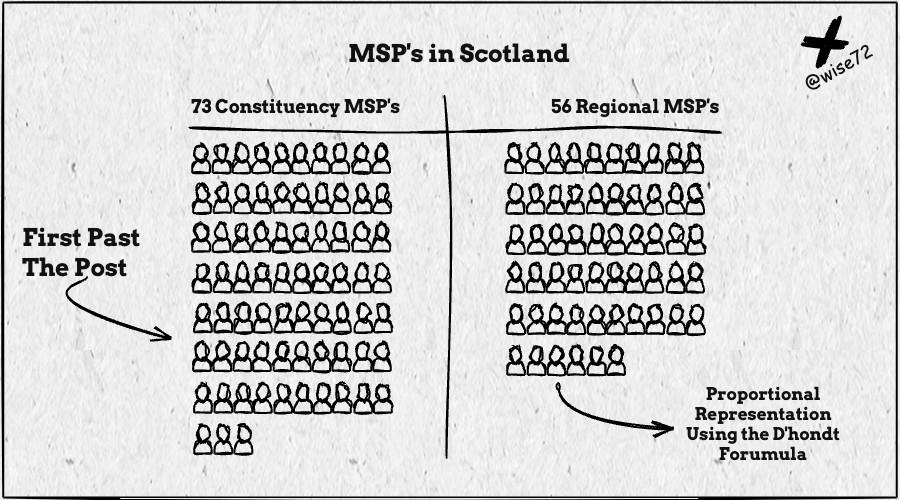How are MSPs elected in Scotland?
- Lee Wisener
- 10-07-2024
- Guides
How are MSPs in Scotland elected? That is what I am going to cover in this article. Surprisingly, many I speak to don't realise we have an element of proportional representation in Scotland when it comes to elections.

Table of contents
The method of electing a Member of the Scottish Parliament (MSP) differs from England, although it's partly the same. Not everyone understands it fully, so I thought an article explaining it in more detail would be useful.
We use Scotland's First Past The Post (FPTP) system and the Additional Member System (AMS), which is referred to as the mixed electoral system.
In a Scottish election, each voter is given two ballot papers. The first is a vote for a specific candidate in the constituency, and the second is a vote for a party.
Scottish Government in numbers
129 MSPs elected in Scotland have a seat in the Scottish Parliament. They are broken down as follows.

So, let's break that down into the two parts of the system used to select MSPs.
Constituencies - FPTP
One MSP is elected using the FPTP for each of Scotland's 73 constituencies, which is true in England.
Each party has a candidate in all or most constituencies (their choice), and each registered voter casts one vote for their preferred candidate. As the name suggests, the winner is the FPTP. That is whoever gets the highest number of votes. For example:
| Candidates | Number of votes received |
| Candidate A | 10,000 |
| Candidate B | 9,000 |
| Candidate C | 5,000 |
| Candidate D | 2,000 |
In the example above, Candidate A wins as he/she has the highest number of votes and becomes or continues to be an MSP.
There are regular calls for the First Past The Post system to be reformed. While Candidate A won, Candidate B, for example, still got 9,000 votes, just 1,000 less than the winner. So there was a lot of support for that candidate, but with First Past The Post, there are no prizes for second place. Or 3rd and 4th in this case.
That is where the Additional Member System (AMS), the next part of the Scottish election process, comes in.
Regions - AMS
In addition to the 73 constituencies, Scotland is also split into 8 regions. In each region, 7 more MSPs are elected. These 7 MSPs are not elected by voting for them; instead, a vote is given to the Party of the voters' choice.
For reference, the 8 regions are:
- Central Scotland
- Glasgow
- Highlands & Islands
- Lothian
- Mid Scotland & Fife
- North East Scotland
- South Scotland
- West Scotland
This is where the second ballot paper comes into play when voting in a Scottish election. A voter is given a choice of parties to which their vote can be given.
The votes for each region are counted, and the 7 regional MSPs are split based on the Proportional Representation method. For example:
| Party | Number of votes received |
| Party A | 25,000 |
| Party B | 24,000 |
| Party C | 10,000 |
| Party D | 9,000 |
The Divisor Calculation is used to allocate the 7 available seats. Each party's votes are divided by the number of constituency seats they have already won plus 1. For simplicity, I will assume no party has won any constituency seats already.
| Round | Party A | Party B | Party C | Party D | Seat Won by? |
| 1 | 25,000 | 24,000 | 10,000 | 9,000 | Party A |
| 2 | 12,500 | 24,000 | 10,000 | 9,000 | Party B |
| 3 | 12,500 | 12,000 | 10,000 | 9,000 | Party A |
| 4 | 8,333 | 12,000 | 10,000 | 9,000 | Party B |
| 5 | 8,333 | 8,000 | 10,000 | 9,000 | Party C |
| 6 | 8,333 | 8,000 | 5,000 | 9,000 | Party D |
| 7 | 8,333 | 8,000 | 5,000 | 4,500 | Party A |
So what happened above? It may not make sense so I will walk through some seats.
Again, the divisor calculation, referred to as the d'Hondt method, is used. In each round for the 7 seats, we divide the votes received by the seats won.
In round one of the example above, no seats had been won, so the numbers stayed the same. The seat went to party A, as they had the highest votes overall.
In round 2, we apply the d'Hondt method to party A, which has already won a seat. We take 25,000 votes and divide by 2, leaving 12,500. The other parties still have no seats, so the number of votes remains the same. As a result, party B now has the highest number of votes, so they get seat 2.
In round 3, we again apply the d'Hondt method to Party A, which stays at 12,500. We then used that same method for Party B, which reduced their number to 12,000. Party C has the highest number, so the Seat goes to them.
And so on. The result;
Party A gets 3 seats
Party B gets 2 seats
Party C gets 1 seat
Party D gets 1 seat
The result is that each party is allocated seats using proportional representation.
The reality will look very different: there will be much higher numbers in an election, and parties will already have won seats regarding regional voting.
How are those regional MSPs chosen?
Given that each voter is giving their regional vote to a party and not a candidate, who is given each seat? Before each election, each party must submit a list of 7 candidates in preferred order.
So, in our example above, Party A won 3 seats; therefore, the first 3 candidates on the list will become MSPs or remain as regional MSPs if they already were one. The same applies to the other parties.
If you're a party member, they may offer you some say in who the 7 candidates are or give you a say in who the preferred candidates are. They have no obligation to do so.
Note
That's a basic overview of how a Scottish election works; I hope it was helpful to some.
In my opinion, the Scottish system is fairer than using FPTP alone. Could it be better? I am sure it could, although, in countries that rely solely on Proportional Representation, I see as many issues, so there is no perfect system.
I was reminded how our system can be good in Scotland. A friend wanted to vote for the SNP but didn't like the candidate's values in the constituency, so she voted for the Liberal Democrats. However, she gave the regional vote to the SNP.9,000
Lee Wisener
I am the Admin of this site. I created it from scratch, and I made all the content. The bottom line is that I'm it if you're looking for the person responsible! We now have a new support system, please log in and use it rather than email where possible.





Comments (0)
Want to comment on this page? Login or Register.